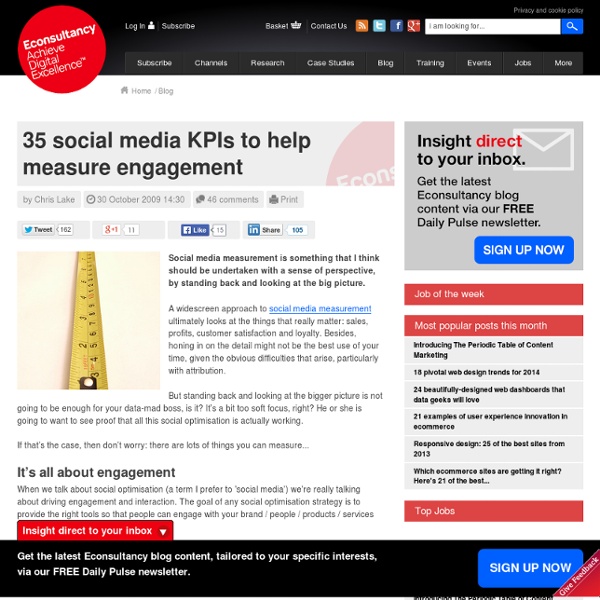Social Media Measurement
Social Media Measurement 101
USING SOCIAL MEDIA IS JUST not optional anymore for many marketing, communications, PR, and web professionals working at colleges and universities. While Facebook, Twitter, YouTube, Flickr, and LinkedIn as well as other social networking websites were only used by a small group of institutions just two years ago, they have now become default communication platforms for the majority in trying to reach and engage students, alums, and other constituents on their terms and at a minimum cost. Things go fast with the social web? Whether or not they include stats on your page or channel, most social media platforms won't provide a full picture. Using social media doesn’t require big budgets. So how do you make sure you don’t waste your time? 1. Clear goals make the difference between strategy and mere tactics. 2. Determine how you will measure success? 3. While Facebook and YouTube provide a wide range of metrics about your page or channel, Twitter and LinkedIn don’t. 4. 5. 6. 7.
WE launches Twendz upgrade for professionals
Social Media Measurement
Hot on the heels of last week’s Altimeter Open Research Report on Converged Media, today, analyst Susan Etlinger, Researcher Andrew Jones, (I served as editor) have published a report answering the absolute top asked question in the social space: “How do companies measure ROI of social?” In this definitive report, Altimeter found that there are half a dozen methods being deployed, each with flaws and strengths. It’s key that the business knows which method to deploy, when, and then line up the right process, teams, software, and partners to help. Despite a thorough look into leading case samples and speaking with dozens of members of the ecosystem, we found there is no single solution that is fool proof. In this Open Research report, you will find: A through set of industry findings with 16 brands, 38 vendors, 3 agencies and 4 ecosystem contributors, and surveyed 71 social media and analytics practitioners. Key Finding: There is no “one-size-fits-all” approach. Take Action Now
Social media measurement - basic metrics
Social media is easy to measure. That’s one of the most compelling factorsof online behavior – it’s trackable and comparable. And for marketers that means we can combine the creative right-brained activities with the logical left. We can fly by instruments, not just gut reaction. So what should you be tracking as a minimum? Blog – traffic over time, comment numbers over time, posts, comments per post, inbound links, RSS subscribersThe goal here is to track your reach and basic level of engagement. Obviously, you can track a lot more data than this, but this should give you a good overview. There are many methodologies for social media measurement. In the first instance, the metrics above should be quick to set up and quick to manage. Tags: measurement, PR, Public Relations, Social Media
twitter influence
You know the world’s turning upside down when a four year-old blog run from Scotland is more influential than one of America’s oldest and most trusted news networks. That’s apparently the case though, on Twitter at least. A study by The Web Ecology Project in America has looked at how influence works on Twitter. Defining ‘Influence’ as “the potential of an action of a user to initiate a further action by another user”, they reached some pretty interesting conclusions. Apparently: • Mashable is more influential than CNN. • Sockington is more influential than MCHammer, while MCHammer is more influential than three major social media analysts (garyvee, Scobleizer, and chrisbrogan). • Celebrities with higher follower totals (eg., THE_REAL_SHAQ and ijustine) foster more conversation than provide retweetable content. • News outlets, regardless of follower count, influence large amounts of followers to republish their content to other users. How the Web Ecology Project defined Twitter Influence
Measuring social media (2)
To get a better understanding of what constitutes best practice in social media measurement and evaluation, we thought the simplest thing to do was to “eat our own dog food” and use our own social media measurement tools to determine who had influence on the topic of “social media measurement” and then look in detail at what they had to say. We wanted to know who owned the consensus around the topic. First we used Market Sentinel’s proprietary web crawler to undertake a Market Influence study. In this case, a “stakeholder” is any individual or organisation who is mentioned in the context of “social media measurement”. 1) Search the web and identify documents (web pages, Word, pdf or PowerPoint documents) that reference “social media measurement” 2) Search those documents for references to other documents 3) Visit the referenced document and determine whom they reference The analysis is focused on identifying who references whom. [Click for full table] (Click for full-size network. 1.



